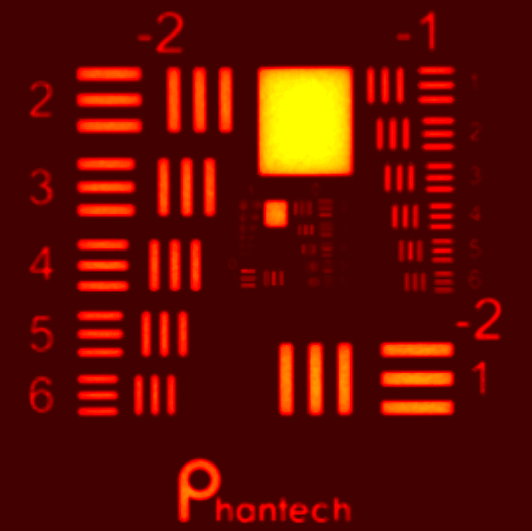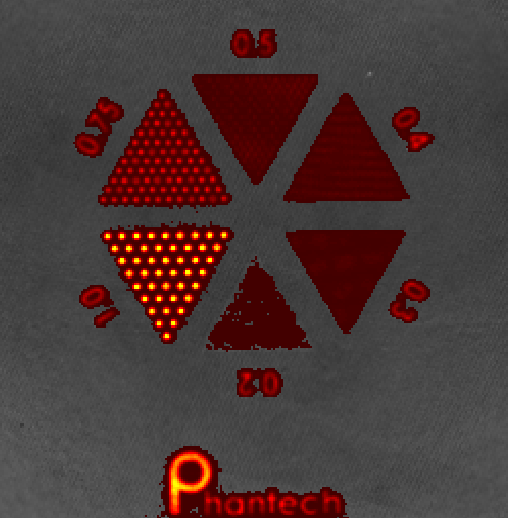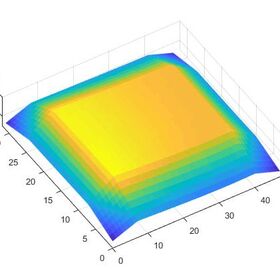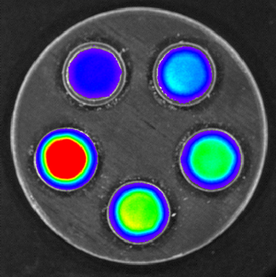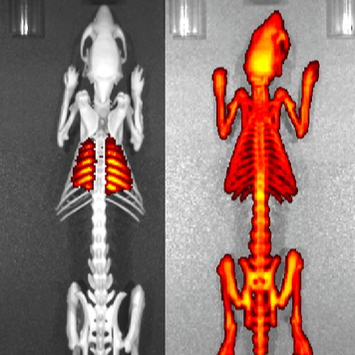Fluorescence/Luminescence Line Pair (USAF 1951) Resolution PhantomPhantech offers the first commercially available line pair phantom for evaluating the resolution of your fluorescence and/or luminescence optical imaging system. Our propriety materials emit both fluorescence and phosphorescence light, covering the entire visible spectrum and extending into NIR. Our phantom’s fluorescent spectral wavelengths are characterized to be best suited for almost any optical system, including fluorescence-guided surgical systems, fluorescence and bioluminescence research imaging systems, and fluorescence microscopes. This 3"x3" 1951 line pair design, which is based on spatial frequencies developed by the United States Air Force, is an adopted standard used to characterize and validate the resolution of your optical imaging system. Contact us at [email protected] for quotes and more information.
|
Fluorescence/Luminescence Derenzo Resolution PhantomsPhantech offers the first commercially available derenzo pattern phantom developed to evaluate the resolution of your fluorescence and/or luminescence optical imaging system. This phantom, unlike the traditional 1951 USAF line pair resolution phantom, simulates the optical signal typically expected with in vivo imaging. Our propriety materials emit both fluorescence and phosphorescence light, covering the entire visible spectrum and extending into NIR. Our phantom’s fluorescent spectral wavelengths are characterized to be best suited for almost any optical system, including fluorescence-guided surgical systems, fluorescence and bioluminescence research imaging systems, and fluorescence microscopes. Contact us at [email protected] for quotes and more information.
|
Fluorescence/Luminescence Uniformity/Flat Field PhantomsPhantech offers the first commercially available flat-field phantoms to evaluate uniformity of your fluorescence and/or luminescence optical imaging systems. These phantoms are designed to improve optical quantitative accuracy by exploiting variations in detector sensitivity and allowing the normalization/correction of inhomogeneity in the field-of-view. They are also used as quality management tools to ensure system stability and optimal performance over time. Our propriety materials are both phosphorescent and fluorescent, covering the entire visible spectrum and extending into NIR. Our phantom’s fluorescent spectral wavelengths are characterized to be best suited for almost any optical system, including fluorescence-guided surgical systems, fluorescence and bioluminescence research imaging systems, and fluorescence microscopes. Our optical phantoms can be customized to fit nearly any size or shape to meet your specific needs. Contact us at [email protected] for more information.
|
Fluorescence/Luminescence Linearity (Concentration Sensitivity) Phantom Phantech's fluorescence/luminescence linearity phantoms offer a standardized method to assess the linearity (concentration sensitivity) of your optical system. Our proprietary fluorescence/luminescence phantoms are made of solid, stable and uniform light emitting materials which are linearly absorbed by well-characterized optical density filters, creating a linear response of light transmission as a function of concentration. These phantoms can be manufactured in 1 of 9 different fluorescent materials (spectra shown in the link below), spanning the entire visible spectrum and extending into NIR in order to simulate the most commonly used fluorescent probes. Additionally, all 9 materials emit phosphorescence light which can be detected using standard luminescence protocols. Contact us at [email protected] for more information.
|
Fluorescence/Luminescence Anthropomorphic Mouse/Rat PhantomsAnthropomorphic mouse and rat phantoms are used to generate anatomically correct test images. By using a proprietary and novel 3D printing material that is both phosphorescent and fluorescent at a wide band of wavelengths, we can create anthropomorphic phantoms for optical and bioluminescence systems.
The phantom shown to the right is a model of a rat skeleton. The model was created by extracting the skeleton from a high resolution CT dataset of a healthy mouse. Structures other than skeletons can be created as well, depending on the individual needs of a user. Please contact us directly for more information about sizes and shapes available and for pricing information. |
